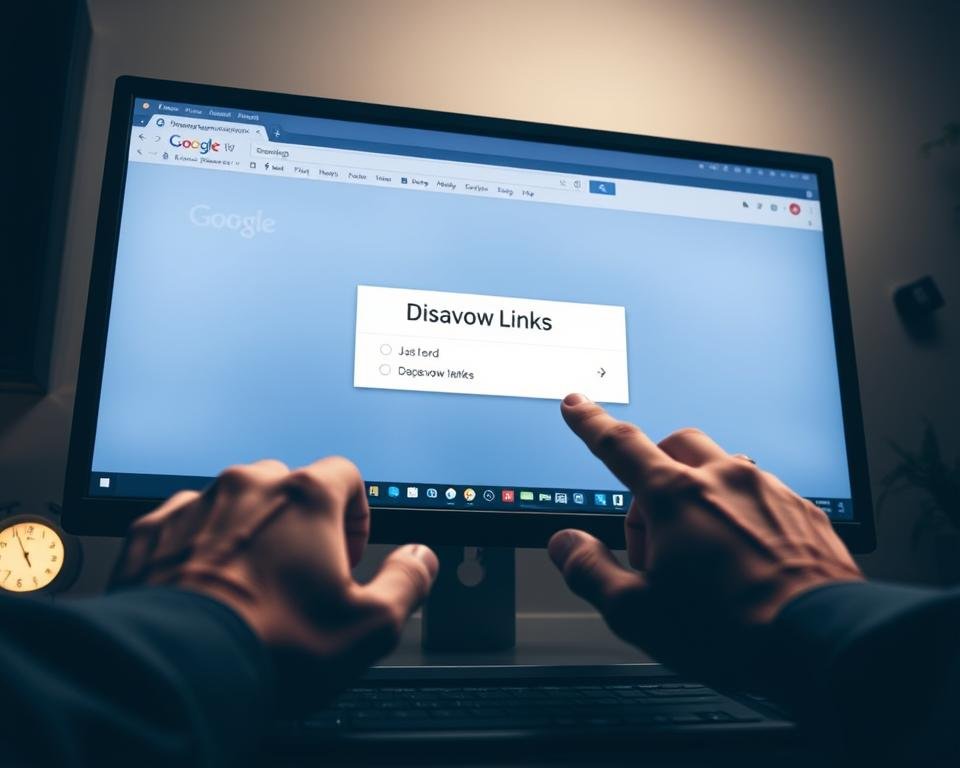Keeping your website healthy is key for SEO. It’s important to handle toxic backlinks well. They can hurt your site’s trust and ranking.
As a website owner, knowing about backlink monitoring is vital. You must act fast if you find any problems.
In this article, I’ll show you how to spot and fix toxic backlinks. This will help keep your site good for search engines.
Key Takeaways
- Understanding the impact of toxic backlinks on your website’s SEO
- Identifying toxic backlinks using effective tools and techniques
- Learning how to disavow toxic backlinks using Google’s Disavow Tool
- Best practices for ongoing backlink monitoring
- Strategies for maintaining a healthy backlink profile
Understanding Toxic Backlinks
Knowing about toxic backlinks is key for a good SEO plan. Toxic backlinks are links from other sites that can hurt your site’s ranking and trustworthiness.
What Are Toxic Backlinks?
Toxic backlinks are low-quality or spammy links that point to your site. They can come from spammy forums, fake news sites, or link farms. These links are called “toxic” because they break Google’s rules on link schemes.
For example, links from sites with no relation to your content or made just for links are toxic. It’s important to find these links to keep your site safe.
Why They Matter for SEO
Toxic backlinks are very important for SEO because they can get you penalties from search engines like Google. If Google sees a lot of manipulative links, it might lower your site’s ranking.
Also, too many toxic links can make your good links less valuable. This makes it harder for your site to rank well for important keywords. So, knowing and managing toxic backlinks is a big part of SEO backlink analysis.
Signs of Toxic Backlinks
Finding toxic backlinks needs a detailed link auditing process. Some signs include:
- Links from sites with low domain authority
- Links from sites with irrelevant or fake content
- Links with anchor text that is overly optimized for specific keywords
- Links from sites that are not relevant to your niche
By spotting these signs, you can act fast to remove toxic backlinks. This helps keep your site’s SEO healthy.
How Toxic Backlinks Affect Your Website
Toxic backlinks are bad for your website’s reputation and search engine ranking. They can cause many problems that hurt your site’s performance.
Impact on Search Engine Rankings
Toxic backlinks can make your website’s search engine rankings go down. Search engines like Google see these links as spam. This can lower your site’s ranking in search results.

Potential for Penalties
Toxic backlinks can also lead to manual penalties from search engines. If Google finds manipulative linking, your site might get penalized. Getting out of these penalties is hard and takes a lot of time.
Diminished Trustworthiness
Toxic backlinks can make your website seem less trustworthy. Search engines and users might see your site as less reliable. This can hurt your site’s ability to attract and keep visitors.
To avoid these problems, check your backlinks often and remove any bad ones. This helps keep your website safe and healthy online.
Tools for Monitoring Backlinks
There are many tools for tracking backlinks. They help you keep an eye on your website’s backlinks. This is key for a good SEO strategy.
Google Search Console
Google Search Console (GSC) is a top tool for backlink monitoring. It shows who links to your site and spots bad links. It’s free and linked to Google’s search data, making it trustworthy.
Key Features of Google Search Console:
- Detailed backlink data
- Integration with Google’s search data
- Free to use
SEMrush
SEMrush is a big SEO tool with backlink monitoring. It checks your backlinks, looks at competitors, and alerts you to changes.
Benefits of Using SEMrush:
- Comprehensive backlink analysis
- Competitor backlink analysis
- Customizable alerts for backlink changes
Ahrefs
Ahrefs is famous for its backlink analysis. It gives lots of data on backlinks, like quality and anchor text. It also has tools for content and keywords.
Ahrefs Key Features:
- Extensive backlink database
- Detailed link quality analysis
- Content and keyword analysis tools
Moz Link Explorer
Moz Link Explorer is a strong tool for backlink analysis. It shows your link profile, like domain authority and spam score. Moz also has other SEO tools.
Moz Link Explorer Highlights:
- Domain authority and spam score analysis
- Anchor text distribution insights
- Integration with other Moz SEO tools

Using these tools helps you watch your backlinks, find bad ones, and keep your profile healthy. Each tool has special features. It’s good to try them out to see which fits your SEO best.
Regularly Reviewing Your Backlink Profile
I check my backlink profile often to keep the quality of links high. This is key for a strong SEO plan and avoiding search engine penalties. By watching your backlinks, you can spot and fix any bad links that hurt your site’s trust.
Setting a Monitoring Schedule
To keep an eye on your backlinks, set a regular auditing schedule. You might check monthly, every three months, or every six months. It’s important to be consistent to catch bad links early.
Think about how often you post new content, changes in search engine rules, and how fast your site gets new links. Google Search Console can give you useful info about your backlinks and help plan your checks.
Key Metrics to Track
When you review your backlinks, watch a few key metrics to see how they’re doing. These are:
- The total number of backlinks
- The quality and relevance of linking domains
- Anchor text distribution
- Link growth rate
Looking at these metrics helps you understand your backlink profile better. You can see where you need to do better.
Creating a Backlink Inventory
Keeping a detailed list of your backlinks is very important for backlink quality assessment. You need to list your backlinks and check their quality. Look at things like domain authority, relevance, and trust.

A good backlink inventory helps you find bad links and plan better link building. It lets you aim for getting high-quality backlinks that help your SEO.
Identifying Toxic Backlinks
Finding toxic backlinks is key to a healthy backlink profile. These links can hurt your site’s rankings and trust. It’s vital to spot and remove them.

Manual Review Process
Checking your backlinks by hand is a detailed process. You look at where the link comes from, the text used, and if it matches your content.
Important things to check include:
- The linking domain’s trustworthiness
- If the linking page is relevant to your content
- Any manipulative anchor text
Using Automated Tools
Automated tools can help find toxic backlinks faster. Tools like SEMrush, Ahrefs, and Moz Link Explorer check your links. They look for signs of toxicity.
Benefits of automated tools are:
- They quickly scan big backlink profiles
- Spot patterns and oddities that might mean trouble
- Keep an eye on new or changed links
Analyzing Link Quality Criteria
Knowing what makes a link good is key. Look at the linking page’s content, the anchor text, and the domain’s trustworthiness.
Criteria for link quality are:
| Criteria | Description | Impact on Link Quality |
|---|---|---|
| Linking Domain Authority | The domain’s credibility and trust | High authority domains are better |
| Relevance | How well the linking page matches your content | Relevant links are better |
| Anchor Text | The text in the hyperlink | Natural, varied anchor text is best |
Creating a Disavow File
Making a disavow file means finding bad links, setting them up right, and sending it to Google. This is key to fixing bad backlinks that hurt your SEO.
What to Include in Your Disavow File
When making a disavow file, list all bad backlinks you find. These are links that are spammy or don’t match your site. Make sure only bad links are in your file, as wrong links can hurt your SEO.
To find bad links, use tools like Google Search Console, SEMrush, or Ahrefs. They help spot bad links in your backlink profile. After finding them, write them down right in your disavow file.
Formatting Your Disavow File
A disavow file is a text file with a special format. Each line should have one link or a comment with a “#” symbol. For example:
http://example.com(a single URL to disavow)domain:example.com(to disavow all links from a specific domain)
It’s very important to follow this format for Google to understand your file. Any mistakes can make Google reject your file.

Where to Submit Your Disavow File
When your disavow file is ready, send it to Google through Google Search Console. Here’s how:
- Log in to your Google Search Console account.
- Select the property (website) you want to disavow links for.
- Navigate to the “Links” section and then click on “Disavow links.”
- Upload your disavow file.
After you send it, Google will work on your disavow file. They’ll ignore the bad links when checking your site’s backlinks. It’s smart to check and update your disavow file often for better SEO.
Submitting Your Disavow File to Google
First, find toxic backlinks. Then, send a disavow file to Google. This tells Google to ignore those links. It helps avoid penalties and keeps your site’s ranking good.

Step-by-Step Submission Process
To send your disavow file, do this:
- Log in to your Google Search Console account.
- Pick the site you want to work on.
- Go to the “Links” section and click “Disavow links.”
- Click “Disavow links” again and then “Upload disavow file.”
- Pick your disavow file (it should be a .txt file).
- Click “Submit” to send your file.
What to Expect After Submission
Google will look at your disavow file. It doesn’t mean they’ll ignore the links right away. They’ll think about them for future visits. Check your file’s status in Google Search Console.
Keep an eye on your backlinks after sending the file. New bad links might show up.
Common Pitfalls to Avoid
Avoid these mistakes when sending your disavow file:
- Don’t list too many links that aren’t bad.
- Make sure your file is in the right format.
- Update your disavow file often.
- Don’t expect results right away.
Stay away from these mistakes. Follow the steps carefully. This helps remove bad links and keeps your site’s backlinks healthy.
The Importance of Continuous Monitoring
Search engine algorithms change often. It’s key to keep watching your backlinks. This helps spot and fix problems before they hurt your site’s ranking.

Establishing Long-term Monitoring Practices
It’s vital to make a habit of checking your backlinks. Use tools like Google Search Console, SEMrush, or Ahrefs. They help you see how your backlinks change over time.
Key practices include: setting a schedule for monitoring, tracking new and lost backlinks, and keeping a detailed list of your backlinks.
Adapting to Algorithm Changes
Search engines’ rules change all the time. To keep up, you need to be flexible. Watching your backlinks closely lets you act fast when new rules come out.
- Keep up with the latest algorithm updates.
- See how changes affect your backlinks.
- Change your SEO plans as needed.
Staying Ahead of Competitors
In the world of SEO, it’s important to stay ahead. Watching your backlinks helps you find chances and dangers. This lets you make smart choices to keep or boost your ranking.
By checking your backlinks often and comparing them to your rivals’, you can find areas to improve. This helps you get better at SEO.
Strategies to Build Quality Backlinks
A good backlink strategy can really help your website be seen more. Getting quality backlinks is key for a strong SEO plan. It makes your site more credible and helps it rank better.
Guest Blogging Opportunities
Guest blogging is a great way to get good backlinks. By writing for other sites, you can get links back to yours. To get the most out of it, focus on:
- Finding blogs that fit your niche
- Writing interesting, top-notch content
- Connecting with editors and influencers
Guest blogging done right can really boost your backlink game and SEO.
Collaborating with Influencers
Working with influencers in your field can get you quality backlinks. Influencers have lots of followers and can share your stuff. This leads to:
| Benefit | Description |
|---|---|
| Increased Visibility | Get seen by more people through influencer networks |
| Quality Backlinks | Get links from important sites |
| Enhanced Credibility | Gain trust with your audience |
Creating Shareable Content
Creating content that people want to share is key for getting good backlinks. Make sure your content is:
- Informative and useful
- Looks good
- Relevant to your audience
This way, more people will share and link to your content. This improves your backlink profile.
In short, getting quality backlinks needs a smart plan. This includes guest blogging, working with influencers, and making shareable content. By using these methods, you can make your website more visible online.
Handling Manual Penalties
A manual penalty from Google is a big wake-up call. It means you need to check your website’s backlinks and SEO. Google’s human reviewers found big problems with your site.
Recognizing a Manual Penalty
To spot a manual penalty, check your Google Search Console. You’ll see a message if you got a penalty. It will tell you what’s wrong and how to fix it.
Look at your website’s backlinks to find the problem. You might find toxic backlinks that are causing trouble.
Steps to Recover from a Penalty
To get out of a penalty, you need to take several steps:
- Find and list the bad backlinks.
- Make a disavow file for Google. This tells them which links to ignore.
- Try to get rid of the bad links or fix them.
- Send a reconsideration request to Google. Explain what you’ve done to fix things.
Communicating with Google
Talking to Google is key when you have a penalty. When you ask for reconsideration, be clear about what you’ve done.
Your reconsideration request should have:
- A clear admission of the mistake.
- Details of what you’ve done to fix it.
- Proof, like removed bad links.
Here’s how to write your reconsideration request:
| Action | Description | Status |
|---|---|---|
| Identified Toxic Backlinks | Reviewed backlink profile using Google Search Console and identified toxic links. | Completed |
| Created Disavow File | Compiled a list of toxic backlinks to disavow. | Completed |
| Removed Toxic Backlinks | Contacted webmasters to remove harmful links. | In Progress |
By following these steps and talking openly with Google, you can fix penalties. This helps your website rank better again.
Evaluating Backlink Profiles of Competitors
Looking at your competitors’ backlink profiles can teach you a lot. You learn about their link building plans and find chances or dangers for your SEO.
To check your competitors’ backlinks well, you need to know their plans. Look at their backlink quality, spot bad links, and change your outreach plans.
Learning from Competitor Strategies
Knowing how your competitors build backlinks can help you a lot. By studying their backlinks, you see patterns that can guide your own link building.
Use tools like Ahrefs or SEMrush to study your competitors’ backlinks. These tools show you what content gets links, the link text, and the sites’ authority.
| Competitor | Backlink Quality | Toxic Links | Link Building Strategy |
|---|---|---|---|
| Competitor A | High | 10% | Guest Blogging |
| Competitor B | Medium | 20% | Influencer Outreach |
| Competitor C | Low | 30% | Directory Submissions |
Identifying Their Toxic Links
Finding bad links to your competitors’ sites helps you avoid penalties. Use Moz Link Explorer to find and check these links.
Looking at bad links to your competitors shows you common problems. This helps you avoid these issues and keep your backlinks clean.
Adapting Your Outreach Efforts
Knowing your competitors’ link strategies and bad links lets you improve your SEO. You might change your tactics, make better content, or pick different link texts.
If your competitors get lots of links from guest blogging, try more guest posts. But, if they have many bad links, don’t follow their link building.
Keep watching and studying your competitors’ backlinks. This helps you make your SEO better and stay competitive.
Best Practices for Healthy SEO
Managing backlinks well is key for a good SEO plan. Knowing how to spot and remove bad backlinks helps keep your site safe. It also boosts your ranking on search engines.
Clean Backlink Profile
Keeping your backlink profile clean means checking your links often. Look for bad links that could hurt your site’s trust. Use tools like Google Search Console, SEMrush, and Ahrefs to watch your backlinks.
Team Education
Teaching your team about toxic backlinks is important. They need to know how these links can harm your site. This way, they can help keep your backlink profile strong.
Disavow List Updates
It’s important to update your disavow list often. This keeps your site safe from bad backlinks. By monitoring and removing toxic links, you keep your site’s SEO healthy.
